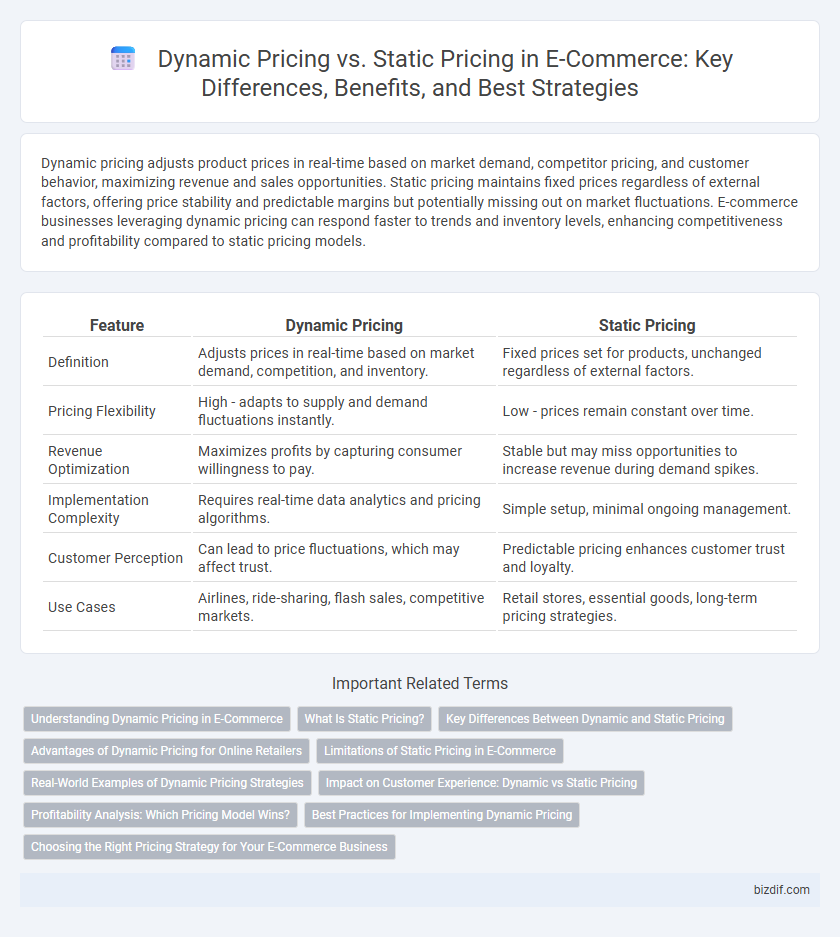Dynamic pricing adjusts product prices in real-time based on market demand, competitor pricing, and customer behavior, maximizing revenue and sales opportunities. Static pricing maintains fixed prices regardless of external factors, offering price stability and predictable margins but potentially missing out on market fluctuations. E-commerce businesses leveraging dynamic pricing can respond faster to trends and inventory levels, enhancing competitiveness and profitability compared to static pricing models.
Table of Comparison
| Feature | Dynamic Pricing | Static Pricing |
|---|---|---|
| Definition | Adjusts prices in real-time based on market demand, competition, and inventory. | Fixed prices set for products, unchanged regardless of external factors. |
| Pricing Flexibility | High - adapts to supply and demand fluctuations instantly. | Low - prices remain constant over time. |
| Revenue Optimization | Maximizes profits by capturing consumer willingness to pay. | Stable but may miss opportunities to increase revenue during demand spikes. |
| Implementation Complexity | Requires real-time data analytics and pricing algorithms. | Simple setup, minimal ongoing management. |
| Customer Perception | Can lead to price fluctuations, which may affect trust. | Predictable pricing enhances customer trust and loyalty. |
| Use Cases | Airlines, ride-sharing, flash sales, competitive markets. | Retail stores, essential goods, long-term pricing strategies. |
Understanding Dynamic Pricing in E-Commerce
Dynamic pricing in e-commerce leverages real-time data analytics and artificial intelligence to adjust product prices based on market demand, competitor pricing, and customer behavior. This strategy maximizes revenue by responding flexibly to fluctuations in supply and demand, unlike static pricing which maintains fixed rates regardless of external factors. Implementing dynamic pricing algorithms allows online retailers to enhance competitiveness and optimize profit margins across diverse product categories.
What Is Static Pricing?
Static pricing refers to a fixed pricing strategy where product prices remain constant over time, regardless of market demand or competition. This approach simplifies inventory management and provides predictable revenue but may result in missed opportunities for higher profits during peak demand periods. E-commerce businesses using static pricing benefit from straightforward customer expectations and easier price communication.
Key Differences Between Dynamic and Static Pricing
Dynamic pricing adjusts product prices in real-time based on market demand, competitor pricing, and customer behavior, maximizing revenue through personalized offers. Static pricing maintains fixed prices for products regardless of external factors, providing price stability and predictable profit margins. Key differences include responsiveness to market changes, complexity of implementation, and impact on customer perception of fairness and trust.
Advantages of Dynamic Pricing for Online Retailers
Dynamic pricing enables online retailers to maximize revenue by adjusting prices in real-time based on market demand, competitor pricing, and inventory levels. This approach improves sales efficiency by attracting price-sensitive customers during low-demand periods while capitalizing on higher willingness to pay during peak times. Leveraging AI-driven algorithms, dynamic pricing also enhances competitiveness and responsiveness in the fast-paced e-commerce market, leading to increased profit margins and optimized stock turnover.
Limitations of Static Pricing in E-Commerce
Static pricing in e-commerce often leads to missed revenue opportunities due to its inability to respond to real-time market demand, competitor pricing, and customer behavior. This rigidity results in less competitive prices, reduced profit margins, and diminished customer satisfaction. Without dynamic adjustments, static pricing fails to optimize sales during peak or low-demand periods, limiting overall business growth.
Real-World Examples of Dynamic Pricing Strategies
Dynamic pricing strategies are prominent in e-commerce platforms like Amazon, where prices fluctuate based on demand, competitor pricing, and inventory levels, enabling optimized revenue and competitive positioning. Airlines and ride-sharing services such as Delta and Uber also employ dynamic pricing algorithms to adjust rates in real-time according to factors like booking timing, seat availability, and peak hours. These real-world applications illustrate how dynamic pricing outperforms static pricing by enhancing market responsiveness and maximizing profit margins.
Impact on Customer Experience: Dynamic vs Static Pricing
Dynamic pricing enhances customer experience by offering personalized prices based on demand, browsing history, and competitor rates, increasing perceived value and purchase satisfaction. Static pricing provides consistency and transparency, fostering trust and reducing customer frustration caused by fluctuating costs. Balancing dynamic pricing algorithms with clear communication ensures an optimal blend of flexibility and reliability in e-commerce transactions.
Profitability Analysis: Which Pricing Model Wins?
Dynamic pricing leverages real-time data and market demand fluctuations to maximize revenue and increase profit margins, outperforming static pricing in competitive e-commerce environments. Static pricing, while simpler to manage, often misses opportunities to capitalize on peak demand and fails to adjust for inventory levels, leading to lower profitability. Profitability analysis consistently shows dynamic pricing drives higher sales volume and improved margin optimization, making it the superior pricing model for e-commerce businesses aiming for sustained growth.
Best Practices for Implementing Dynamic Pricing
Implementing dynamic pricing requires real-time market analysis and customer behavior tracking to optimize revenue without alienating buyers. Leveraging AI algorithms and machine learning models ensures prices adjust accurately to demand fluctuations, inventory levels, and competitor actions. Transparent communication about pricing changes enhances customer trust and improves overall conversion rates in e-commerce platforms.
Choosing the Right Pricing Strategy for Your E-Commerce Business
Dynamic pricing leverages real-time data analysis to adjust product prices based on market demand, competitor pricing, and customer behavior, maximizing revenue and sales efficiency. Static pricing maintains fixed price points regardless of market fluctuations, offering predictability and simplicity in pricing administration. Selecting the appropriate pricing strategy depends on factors such as product type, market volatility, customer expectations, and operational capabilities, ensuring alignment with overall business goals and competitive positioning.
Dynamic Pricing vs Static Pricing Infographic

 bizdif.com
bizdif.com